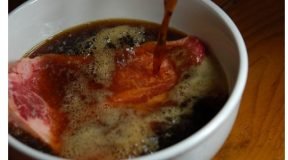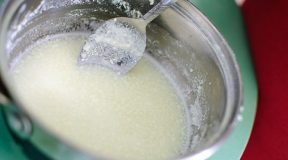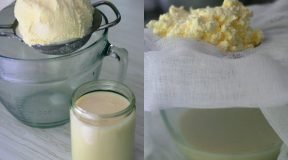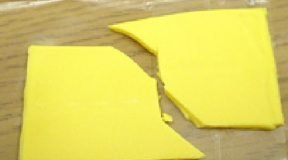100 Best Food science experiments and projects for kids
Science is awesome. Food is awesome. Blending the two together rocks faces off. Teachers and parents looking for some projects to introduce their students to the basic principles of chemistry, physics, biology and more can easily turn to the kitchen for inspiration.
The following experiments vary when it comes to materials, difficulty levels and cost, so read them over thoroughly before making any commitments. Always practice proper safety precautions as well, most especially when tooling around with fire and acids and other lovely things.
Milk, Yogurt & Cheese
- Stained Glass Milk: Turn a simple bowl of cow juice into a work of kinetic art using food coloring and liquid soap, learning all about molecular structure along the way.
- Plastic Milk: Learn how to separate the casein found in milk, ultimately winding up with an intriguing plastic-like substance.
- Cheesequake: A simple slice of American cheese with more processing than Cher’s voice offers up some surprisingly useful geology lessons.
- Homemade Butter: This tasty experiment not only provides a tasty treat, but a valuable look at chemistry and changing states of matter as well.
- Milk Glue: A brew of milk, vinegar and baking soda makes for a viable, sustainable adhesive for minor projects.
- Plastic Bag Ice Cream: This fun, edible experiment allows kids to watch as their milk freezes and undergoes a special process to become a special frozen treat.
- Optimum Tea Temperature: Believe it or not, the time cold milk is added to a cuppa tea can affect its overall taste at different temperatures. This experiment explains how the perfect pour works.
- Moldy Cheese: Different styles of cheese mold at different rates, raising some interesting questions about what factors affect this disparity.
- Everyone Loves Coagulates: Vinegar and milk together make a rather horrifying potion of failure and stench, but it does provide insight into the concepts behind cheesemaking.
- Creamy Carbohydrates: More appropriate for a lab than a kitchen, high school kids with a knack for playing with their food may enjoy testing the carbohydrate levels of different milk varieties.
- Liquid Nitrogen Ice Cream: Steve Spangler shows off a very quick and relatively easy method of making ice cream using the always awesome liquid nitrogen.
- Pasteurization Temperature vs. Bacteria: This experiment questions whether or not a milk’s temperature at pasteurization (and pasteurization itself) has any effect on any bacterial growth.
- Playing with Proteins: Great for a science fair project, especially for kids curious about the protein structures of milk and how they react to both heat and acids.
- Dreamy Cream: Prepare fresh whipped cream in a way that allows it to last much longer than many people would assume.
- DIY Yogurt: Making yogurt at home or in class makes for an excellent way to illustrate how helpful bacteria work — and all the good things they can do for the human body.
- Fun with Milk and Cheese: Depending on the variety of milk used in the process, cheeses come out with different smells, tastes and textures. Find out how.
- Perfect Grilled Cheese: Test different processed cheese varieties in order to see which one results in the most flavorful and aesthetic presentation when grilled.
- Curdling Milk: Check the pH balance of milk as it ages and determine which point results in some gnarly curdling.
- Milking Plants: Question the viability of milk as a means of nourishing seeds and plants with this rather intriguing project.
- The Perfect Cottage Cheese: Variables such as heat and vinegar can create chemical reactions resulting in either horribly or blissful cottage cheese.
Meat, Poultry, Fish, Dry Beans, Eggs & Nuts
- Naked Eggs: Also known as "rubber eggs," this kitchen science classic uses vinegar to dissolve the shell without damaging the entire structure.
- Egg in a Bottle: Another eggy classic, this time involving a match, a bottle and some truly bizarre vacuum physics.
- Bendy Bones: Omnivorous eaters might want to save bones from their meals for use in this experiment on their structural integrity.
- Temperature vs. Bacteria: A great tandem project for kids and their parents, this one inquires about the relationship between heat and bacteria on four different kinds of meat.
- Meat Fizzy Lumpkins: Pour soda on various meats and learn about what carbonation can do to organic tissue — the results directly answer an age-old food myth.
- Energetic Peanuts: Parents and educators need to assist younger students wanting to learn about whether or not peanuts can produce enough heat and energy to boil water.
- Chemical Ch-Ch-Changes: For the budding nutritionist or food chemist, this experiment introduces them to the various stimuli that change a piece of meat once it’s been cooked.
- The Measure of an Egg: Discover whether or not egg production facilities accurately measure their output as well as any variance between varieties.
- Hot, Messy Coagulate: Another experiment involving eggs and heat, this time inquiring about the role the latter plays (or does not play) in coagulating the former.
- Soaking Wet Beans: Chart how much water is needed to perk up different varieties of dried beans — definitely a neat experiment for kids who also want to learn how to cook them properly.
- Folding Egg: Beyond the rubber egg experiment lay the folding variety, which involves draining the yolk and playing around with the remaining membrane.
- Fat Hunt: Cook up some ground beef, drain it and weigh the results for an educational look at fat and food.
- Splitting Sausages: Fire up the barbecue and throw on some cheap sausages — believe it or not, dinner tonight involves a little lesson in how pressure works.
- Whipped into Shape:When it comes time to show those naughty eggs how to behave, the type of bowl used does have an impact on how they turn out.
- Fun with Beans and Liquids: Whip up some delicious dishes and learn about all about which liquids soften beans up the fastest.
- Peanut Butter Roasting: In this delightful experiment, kids can explore what type of effect the roasting process has on peanut butter’s texture, taste and color.
- Hole-y Tofu, Batman.: The popular soy-based protein tofu behaves in a rather interesting manner when stuck in the freezer, illustrating more intriguing elements of its structure.
- How Steaks Conduct Heat: A simple cookout doubles as a nice little lesson in basic physics when steaks are used to illustrate how heat moves throughout a juicy slab of tender meat.
- Preventing Egg-splosions: Teach kids how to build a fun, simple contraption out of straws, popsicle sticks and tape to prevent a dropped egg from breaking and making a terrible mess.
- I’m on a Boat.: Send eggs off on an epic voyage after figuring out how to construct a small boat capable of keeping them afloat.
Vegetables
- Dyed Celery: This science fair staple highlights the feeding habits of plants with simple food coloring and water.
- Cabbage Chemistry: Red cabbage, when distilled into a rather pungent juice, can serve as an excellent indicator of a substance’s acidity or alkalinity.
- Stained Carrot Cells: A bit of shredded carrot and some coloring agents (felt pens or food dye are recommended) teach some cool lessons about cell staining and looking at their individual components.
- Potato Pokin’: This lesson in how air pressure works involve sticking a straw clear through a giant, hard chunk of seemingly impenetrable starch.
- Starchectomy: It takes several hours, but with a small amount of work students can extract some of the starch from potatoes and see what it looks like.
- Root Vegetable Gun: Potatoes, yams and other starchy root vegetables provide kids with both physics lessons and harmless bullets for their toy guns.
- Preserving Cucumbers: The purpose of this experiment revolves around finding the liquid most conducive to keeping cucumbers crisp.
- Suspiciously Spongy Salad: Learn how to grow watercress indoors using a sponge as the base. Similar techniques also work with large sheets of cotton fabric, and spelling one’s name out in seeds is cited as a suggested activity.
- The Joys of Carrot Tops: Even after a carrot has been pulled from the ground and sliced, the leaves can still grow lush and green when placed in a dish of water or hung upside-down.
- You Keep Reaching for that Sun, Potato.: Send a sprouting potato through a labyrinthine construct and marvel at the lengths it will go to for a small amount of precious light.
- Potato Alarm Clock: A humble potato can generate enough electricity to power a small alarm clock — but not enough to give a frightful shock to a human.
- Steve Spangler’s Electric Pickle Experience: Pickled cucumbers boast enough acidity to power a light bulb, as this interesting experience attests.
- Cooking the Vitamin C Out of Potatoes: Find out how different preparation methods change the amount of Vitamin C in potatoes — definitely useful information for when cold season blows into town.
- Superhot Insecticide: This experiment works best for high school science fair projects, as it involves crickets and their reactions to an extract of Bird’s Eye chilies.
- Blanche Yourself Before You Wreck Yourself: Learn about the effect of the blanching process has on the overall quality of frozen vegetables.
- Hello Kimchi: As this fiery hot cabbage-based condiment ferments, it doubles as a pretty neat lesson in a chemical change important to the food and beverage industry.
- Vitamin C Levels in Bell Peppers: Test whether or not Vitamin C levels fluctuate as bell papers ripen with this interesting experiment.
- Carrot Pump: Use the beloved root vegetable to build a small, pump-like structure illustrating the basic principles behind osmosis.
- Soda Bottle Nursery: The instructions for this project may not necessarily call for vegetable seeds, but it still makes for a grand project for growing some.
- Water Uptake in Celery: Discovery Education’s Science Fair Central offers the basics for designing an experiment based around testing the effect of water temperature on a celery’s uptake.
- Vegetable Oil Lava Lamp: Making a funky homemade "lava lamp" (no heat required.) and learn a few very basic chemistry lessons along the way.
Fruits
- The Grape Juice Test: Use grape juice splashes in order to test the efficacy of different household cleaners.
- Citrus Battery: Learn about how citrus fruits make for amazing conductors of electricity by building a small battery.
- Watermelon Go Boom: Kids and their adult supervisors can channel their inner Gallagher using gas and fire to create an exploding, "self-carving" watermelon.
- Invisible Ink: Use lemon juice to create both invisible ink and a child-friendly chemistry experiment.
- Stop Apple Browning: Lemon juice is known to keep apples, pears and other crisp fruits beautiful and fresh, and this extremely easy experiment offers up some cool kitchen chemistry lessons.
- Calculate Banana Carbohydrates: An undertaking involving the carbohydrate count of bananas and glucose test strips works best with high school students.
- Kiwi DNA: Most students past a certain age know that life is comprised of DNA strands, but they probably don’t realize that a simple kiwi fruit can grant them an opportunity to actually see some.
- Fruity Flambe: Oranges are awesome. Fire is awesome. Oranges on fire are epic. And educational. But mostly epic.
- Applehotep III: Get an extremely basic understanding of the mummification process by dehydrating an apple in a manner that discourages bacterial infiltration.
- Plasma Grapes: Chunk a grape into the microwave as a means of better understanding the nature and structure of plasma — the most frequently overlooked state of matter.
- Floating Lemon: Food science meets basic physics in this incredibly simple experiment on the buoyancy of a favorite fruit.
- Homemade Orange Soda: This tasty recipe doubles as a chemistry experiment, most especially pertaining to the behavior of gases such as carbon dioxide.
- Lemonade Volcano: Everyone knows about the Mentos and cola phenomenon, but mints and lemonade can also simulate volcanic activity as well.
- Ripening Bananas: Set up bananas in different settings and witness which ones end up ripening the fastest.
- The Power of Preservatives: Applesauce’s color changes when mixed with different preservatives, which does impact its USDA rating.
- Yeasty Apple Juice: Discover whether or not the pH of apple juice can potentially encourage or hinder the fermentation of Bakers Yeast.
- Clearing the Apple Juice: This project is better suited for science fair projects at home than daily dalliances because a small amount of carbon needs to be purchased.
- Testing pH: Toss a few favorite fruits in a blender and use the resulting pulpy mess to test the different pH balances between them.
- Ninja Banana Slicing: It’s possible to slice a banana without ever peeling it. Once the painfully ’90s movie trailer record scratch noise wears off, grab a sterilized needle and follow the listed directions.
- Unequal Distribution of Sweetness: Sunkist asks kids to try different parts of an orange and make note of the differences in taste and texture. There are biological reasons for this phenomenon.
Bread, Cereal, Rice and Pasta
- Bread Mold Farm: It takes a few days, but this experiment introduces kids to the behavior of mold spores as they take root in bread slices.
- Cereal Magnets: How Do They Work?: Pick out an iron-rich cereal and grab a magnet, a plastic bag and some water. This experiment allows budding scientists to actually see the iron they consume for breakfast.
- Do the Spaghetti Boogie: See what happens when spaghetti is placed in baking soda and vinegar and compare the results to its
behavior in water.
- Cornstarch Goo: A staple of science classrooms and kitchens everywhere, the cornstarch goo with an interesting consistency is an old favorite for a reason.
- Crackerquake: Just like that ol’ slice of American cheese, graham crackers also bring geological phenomena into the kitchen or classroom.
- Spaghetti Structure: The simple act of bending dry spaghetti provides some intriguing insights into its overall structure — and some very basic physics principles, too.
- Volcanic Flour: For a starchy twist on an old favorite, construct a model volcano using a mound of flour to support the always enjoyable mock eruptions.
- Dropping Bread: This experiment dives into the belief that bread always falls with the butter side facing downward, analyzing the different results in different situations.
- Bread Preservatives vs. Mold: Watch as mold grows — or does not grow — on different bread slices exposed to different conditions and analyze the role preservatives play in decomposition.
- Hot Popcorn Action: This incredibly fun experiment questions whether or not storage conditions have any impact on the quality of microwave popcorn.
- Flour Paste: A boiled blend of flour and water makes for a weak but viable paste for minor adhesive jobs.
- Fun with Rice Krispies and Static: Static electricity generated by a wool sweater causes Rice Krispies to leap and bound across a table – much to the delight (and education.) of children.
- The Science of Popcorn: Every pop of the beloved movie-time grain involves a complex process of steam power and physics, as this simple experiment illustrates.
- Dancing Rice: A bit of rice, a bouncy ball and a pint glass come together to illustrate the basics of tiny air currents and the physics behind them.
- Basic Baking Science: Many culinary arts aficionados appreciate the painfully precise science that goes into baking, and this experiment doubles as a recipe for finding the optimum amount of baking powder when preparing bread dough.
- Globules of Gluteny Goodness: Introduce students to the wonderful world of gluten by designing an activity based around discovering which types of flour yield the highest amount of this substance.
- Like Water for Pasta: Get a glimpse at the chemistry of this ancient Chinese dish and experiment with how much water is needed to make it nice, soft and a wee bit chewy.
- Baking Powder vs. Baking Soda: This project asks whether or not the home gourmand can viably substitute baking soda for baking powder in a recipe.
- Converting Carbohydrates: Taking a bite of bread and leaving it on the tongue for a while begins converting the complex carbohydrates into simpler ones, as evidenced by a sweeter taste.






